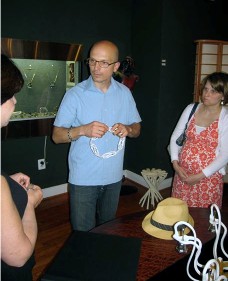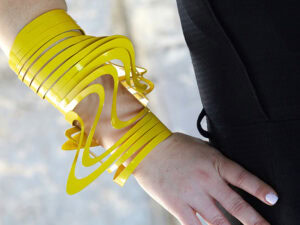The AJF trip to Philadelphia in 2009, was our first in conjunction with the SNAG conference and a whole lot of fun. It was a very good group and everyone had a favorite moment. At the conference itself, I think most everyone would agree that Myra Mimlitsch Gray gave the most inspired talk. She got a standing ovation. We learned a lot of history from Stanley Lechtzin and Helen Drutt’s panel of European historians and curators. More than anything, though, I think there was a lot of talk that circled around the computer-produced jewelry taught at Tyler. Whether you love it or hate it, whether it is hand or machine made, or restricted in its creativity or not, the interest is there now for the students.
Jennifer Cross Gans: ‘It was an excellent program, focusing on the new hi-tech aspects of jewelry making and on-line communication. There were an impressive number of students present, clearly the future of the profession, but hard to organize and a challenge to get involved in SNAG. Plastic and resin jewelry was much in evidence at the SNAG conference, starting with the work of Stanley Lechtzin, a keynote speaker, who was also given the SNAG Lifetime Achievement Award. An increasing number of students are using this technique, taught at several schools, including Temple University’s Tyler School of Art, where Lechtzin has been a professor since 1962. These new pieces are often large, lightweight, with geometric or free-form designs that might be unworkable in metal. On the downside, they lack the tactile feel of metal and are generally in plain white or pastel colors. Time will tell what is their place in the collector’s repertoire!’

More visible collector input would be important, particularly as spokespeople on conference issues. Biggest issue of all – the elephant in the room – was the economy. This was widely but quietly discussed by individual artists, but did not surface as a public concern. How can the producers of art jewelry meet the current challenges, enlarge (or at least maintain) demand for their work? How are collectors reacting to the new economic scene? How do they like the new world of resin, plastics and recycled art? How much do they use on-line sources of information?
Hundreds of conference attendees packed the Philadelphia Museum of Art for a fashion show, Jewelry in Motion, curated and juried by Gail M Brown. Over 30 artists took to the catwalk modeling their own creations.
We also had the remarkable opportunity to visit Hope and Paul Makler in their remarkable apartment.
The Art Alliance had three fabulous shows. One the top floor was the continuation of a show curated by Helen Drutt called Challenging the Chatelaine, which you can see if you purchase the catalog. On the second floor there was a retrospective of Stanley Lechtzin’s jewelry, called Five Decades, 1969 – 2009. Sorry, we couldn’t take photos there. On the bottom floor was (rEvolution) 105 Years of Jewelry and Metalsmithing at The University of the Arts, which featured work by artists who have helped guide the University of the Art’s metals/ jewelry program. The co-curators Sharon Church and Rod McCormick gave us a tour.
And last but not least, on the final day of our trip Melanie Bilenker invited us to visit her home and studio and discussed her delicate narrative jewelry made of her own hair. The images are of scenes from her everyday life.
Gail Hufjay: ‘The trip was amazing. Seeing Klimt02 and Velvet da Vinci’s work in the beautiful B&B was the cherry on top of the ice cream sundae.’
Susan Cummins: ‘I had a couple of favorite moments. The conversation at the B&B with the AJF group, Leo Caballero (from Klimt02) and other artists about who are the most ambitious American jewelers, only to have Leo say he thinks there is only a global community so you can’t ask that question. Then we went on to discuss how we chose jewelry as a collector. It was fascinating. My other favorite moment was seeing Helen Drutt’s house and library, which I had heard about for years but never seen. It is amazing that so much has come out of those tiny old Philadelphia houses. No photos were allowed in the house, sorry!’
Allie Farlowe: ‘The events like our visit to Helen Drutt’s house truly made the trip to Philadelphia for me.’
Jo Lauria: ‘The outside activities that I enjoyed the most were seeing the exhibitions. (Of course, I’m a curator – what else!) Most exemplary were the “three confections” at Art Alliance (each floor more delicious than the one above/below); the show of Tyler’s alumni, past and present at the new Temple/Tyler facility; the badge exhibit at Works Gallery narrated so compellingly by Marjorie Simon and the exhibits at Wexler –”new materials” and “Myra M Gray” . . . ‘
Gloria Askin: ‘It was my first time with the group and I enjoyed it very much.’




